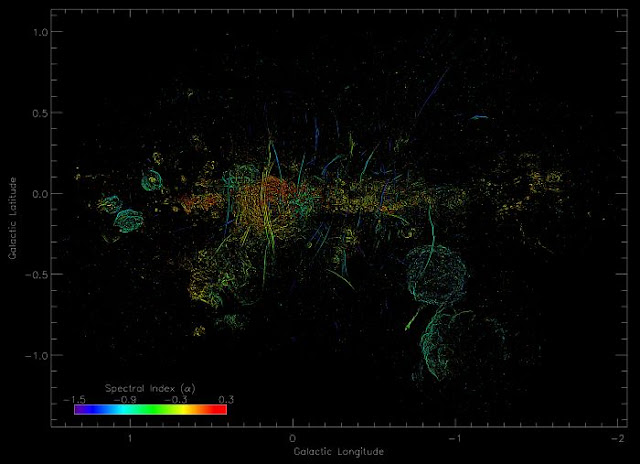A fresh look at the Milky Way's center reveals intriguing, previously unseen features.
crossorigin="anonymous">
style="display:block"
data-ad-client="ca-pub-2375157903127664"
data-ad-slot="7629783868"
data-ad-format="auto"
data-full-width-responsive="true">
The photos, taken with the South African MeerKAT radio telescope's ultrasensitive instrument, reveal around 1,000 filaments of magnetic material arranged in a remarkably neat and orderly fashion.
There are now ten times as many of these strands as we previously knew about, contributing important statistical information that may eventually enable us to unravel their nature, which has remained a mystery ever since their discovery in the 1980s.
The filaments were first identified by astronomer Farhad Yusef-Zadeh of Northwestern University. He says, "We have researched individual filaments for a long time with a myopic vision.
"Now, at last, we see the vast image, a panoramic vista rich with filaments. It is difficult to make any solid conclusions about what they are and where they come from just by looking at a few strands. This is a turning point in how we perceive these structures.
Even though it is only 25,000 light-years away (not far in cosmic terms), the Milky Way galaxy's core is incredibly challenging to observe. Large clouds of dust and gas that blanket it blocks some light wavelengths, including those in the optical spectrum. However, we may modify our vision using technology to see invisible wavelengths.
Since its launch in 2016, MeerKAT, one of the most sophisticated radio telescopes in the world operated by the South African Radio Astronomy Observatory (SARAO), has given us unmatched insights into the galactic core.
Its most recent photograph is definitely a show-stopper. It was created utilizing 200 hours of observation data acquired over a three-year period, and it provides a radio-wavelength image of the region with an unmatched level of detail and depth.
 |
| The spectral index of the galactic center filaments. (Northwestern University/SARAO/Oxford University) |
crossorigin="anonymous">
style="display:block"
data-ad-client="ca-pub-2375157903127664"
data-ad-slot="7629783868"
data-ad-format="auto"
data-full-width-responsive="true">
The background of the image was subsequently removed by Yusef-Zadeh and his team, exposing magnetic filaments arranged in clusters around the galactic core.
What they are and how they came to be are both unknown. We do know that they contain cosmic-ray electrons, which are moving at close to the speed of light within magnetic field filaments.
Researchers have learned more about the strands thanks to the new photos, bringing our understanding of them one step closer.
"For instance, if you were from another planet and you saw one exceptionally tall person on Earth, you could believe that everyone is tall. However, you can determine the average height if you perform statistics on a population of people, according to Yusef-Zadeh.
"Exactly that is what we are doing. We can determine the strength, dimensions, orientations, and radiation spectrum of magnetic fields.
We now know that each filament's whole length amplifies the magnetic field. A supernova remnant that was previously unknown was also discovered by the new data; it has a distinct radiation signature from the filaments. As a result, the supernova remnant is ruled out as the filaments' potential origin.
 |
| A spherical supernova remnant discovered by the MeerKAT team. (I. Heywood/SARAO) |
crossorigin="anonymous">
style="display:block"
data-ad-client="ca-pub-2375157903127664"
data-ad-slot="7629783868"
data-ad-format="auto"
data-full-width-responsive="true">
Previous MeerKAT findings, which were discovered in 2019 and are distinct from the Fermi gamma-ray bubbles found in 2010, confirmed the existence of enormous radio bubbles spreading above and below the galactic plane. Although future filaments are probably characterize research will be required, it's probable that the filaments are connected to these radio bubbles.
The updated details added fresh insight into the mystery. According to the researchers, the filaments are arranged into groups, or clusters, and are quite uniformly spaced within those clusters, resembling harp strings.
According to Yusef-Zadeh, they "nearly match the regular spacing in solar loops." "We still don't understand why they form clusters, how they disperse, or how these regular spacings occur. Numerous new questions come up every time we address one.
We also don't fully comprehend how magnetic filaments accelerate electrons. The filaments might be associated with an odd magnetic filament found last year that emits radiation with both radio and X-ray wavelengths.
The next step will be to inspect and characterise each filament individually in order to build a thorough database that will enable in-depth statistical studies.
We've made progress toward a more complete understanding, adds Yusef-Zadeh. But scientific advancement takes place at various levels. In order to fully understand it, more observations and theoretical analysis are required. It takes time to fully understand complicated objects.
The research is accessible on arXiv and has been accepted for publication in The Astrophysical Journal Letters. ArXiv also hosts a companion manuscript explaining the mosaic that was accepted for publication in The Astrophysical Journal. Public access to the data is also available.

Comments
Post a Comment